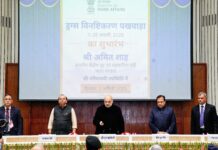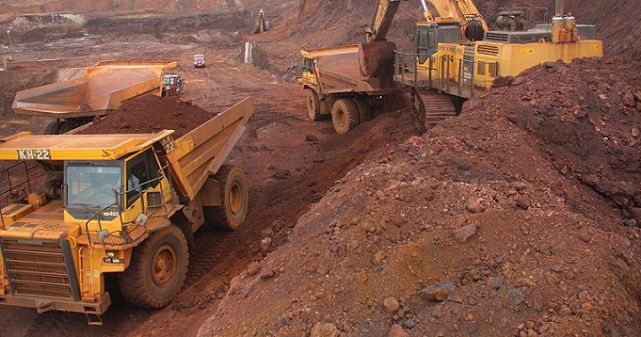By Our Correspondent
BHUBANESWAR/NEW DELHI: The Federation of Indian Mineral Industries(FIMI), has submitted its Pre-Budget Proposals over Direct-Indirect Taxes-GST to Union Finance and Corporate Affairs Ministry, sources said on Tuesday. On issue of Direct Taxes, FIMI demanded depreciation @ 35 % on P&M is allowed in the 1st year and 15 % from 2nd year onwards.The wear and tear of plant & machinery in the capital intensive industry is higher as compared to other businesses.The depreciation allowed under Income tax was 25% until few years back. However the same has been brought down to 15%. The rate should be restored back to 25%.Alternatively, the additional depreciation allowed under section 32(1) should be allowed over 3 years which is normally the life of mining machinery, in place of only the year of acquisition.
Tax rate for individuals / Trust/ HUF/ Firm needs to be rationalized keeping in line with recent reduction in corporate tax rate.The rationale for reduction for corporate tax rate is equally applicable on lowering the existing rate applicable to for individuals / Trust/ HUF/ Firm, since the existing rate is too high, if we consider its impact together with applicable surcharge & cess. This will help a taxpayer becoming more honest and the tax would be affordable leading to better tax compliance and collection.
Clause (iii) of Explanation 1 of Section 115JB provides that brought forward losses or unabsorbed depreciation whichever is less as per books of accounts should be reduced from the net profit to arrive at the book profit.Both are carried forward losses and hence this restriction may please be removed with option to deduct total loss including depreciation.
The blanket exemption earlier available to EOU and SEZ Units in Income Tax was completely withdrawn by way of Sec 115JB and Sec 115JC. To promote development of EOU and SEZ units, the benefits u/s. 10AA and Sec 10B may be given without restrictions.The service tax basic exemption limit was increased from 8 lacs to 10 lacs vide Notification No.: 8/2008 in the year 2008. This limit remains as such for the past 8 years. Request for increasing this exemption limit.Presently no input credit for SBC. Input credit may please be allowed due to practical and procedural difficulties.
Employees’ contribution to Provident Fund – Section 36(1) (va). A suitable amendment should be made in the Act so as to bring the provisions relating to the Employees’ contribution towards employees welfare funds in line with the employer’s contribution towards such funds.Section 43B of the Act allows deduction towards employer contribution to PF / any other fund for the welfare of the employees if the same is deposited before due date of filing the return of income. However, deduction for employees’ contribution to PF / ESI or any other fund is governed by section 36(1) (va) of the Act which mandates that the employees’ contribution should be credited to the relevant fund by the due date specified under the relevant Act, rule, order or notification governing that fund. On this issue there are number of contradictory decisions by different judiciary authorities.
Reduction of Pre-payment of disputed demand on granting stay / disposal of appeals.It is suggested that the rate of pre deposit should be reduced to 10% of disputed tax instead of 20% as fixed with an upper cap.CBDT has increased the pre deposit amount against disputed demand from 15% to 20% for granting stay of demand by department till disposal of first appeal without having any cap in upper limit. It is observed that in many cases demand is raised on assesse by way of high-pitched assessments causes undue hardship to genuine taxpayers and hence payment of 20% of such outstanding demand is resulting a huge cash outlow. Instead, it is suggested that there should be mechanism for early disposal of such cases where the income tax department feels that demand should be recovered at the earliest. The existing rate of 20% for pre-deposits is on very much higher side and detrimental to the business.
Contribution to SPV formed for the benefit of the area in or around mines and its inhabitants @10% on sale value of iron ore should be an allowable deduction under Income Tax act as business expenditure. The Karnataka Government had proposed setting up a special purpose vehicle (SPV) to improve the environment of districts affected by mining. The SPV would formulate and implement projects under the Comprehensive Environment Plan for Mining Impact Zone (CEPMIZ) and would be known as the Karnataka Mining Environment Restoration Corporation (KMERC).
The decision followed a directive of the Supreme Court. Based on a report submitted by the Central Empowered Committee that looked into the impacts of iron ore mining on Bellary, Chitradurga and Tumkur districts in the state, the apex court, on November 2, 2012, had asked the state government to form an SPV. The CEC, in its report submitted to the apex court on October 11, 2012, had recommended formation of an SPV for the implementation of a Rs.30,000 crore comprehensive environment plan, funded by mining companies over 30 years, in districts affected by mining. The panel’s recommendation was that the SPV would implement afforestation and a whole series of programs in the health, nutrition, water supply, employment, soil conservation, biodiversity conservation and minor irrigation sectors, “ for ensuring inclusive growth of the area surrounding the mining leases” in the three districts.
SPV contribution is nothing but a levy imposed on miners to the extent of 10% of sale value as a compulsory expenditure to run the mining business which is wholly and exclusively as expenditure laid out for the purpose of mining business and form an essential part of carrying out the mining business. As such, this expenditure must be allowed as a deductible business expenditure u/s 37 of IT Act while arriving at the taxable income. This has been disallowed by the Income Tax dept without any rationale disregarding the nature of expenditure falling under the purview of residuary eligible deduction u/s 37 with the plea that this expenditure assumes the nature of penalty in the hands of the mining fraternity for earlier misdoings and illegal mining, which is not the case in reality in so far as this liability for SPV contribution is equally applicable for the miners who are proved to be not involved at all in illegal mining. This expenditure is essentially aimed at ensuring benefit to the society at large in and around the mine as well as to protect ecological balances and develop the infrastructure of the adjacent area to the mines.
Notional income should not be added back while computing taxable income against interest free subordinated loan and advances made by the parent company to its foreign subsidiary in order to repay term loan and servicing it to the lender under corporate Guarantee to facilitate financing the project of its subsidiary which has not been generating adequate cash profit.
In order to promote business interest in cross-border countries the promoting company gives some comfort to its subsidiary company as it is rightful obligation to promote its business while giving guarantees to financiers so as to facilitate project financing and giving some interest free loan for fulfilling certain obligation to the lender. In this situation, the notional interest on the interest free loan to subsidiary should not be added back to the taxable income of the holding company. It is primarily the obligation of the promoter to promote its business interest through its subsidiary company in a cross border country during its initial development which requires lot of nourishment after the subsidiary is born in its nascent stage.
Notional guarantee commission should not be subjected to income tax in case the parent company issues Corporate Guarantee to a lender in order to support borrowing by its foreign subsidiary for promotion and development of the parent company’s oversea business through its subsidiary.
This is also true in connection with issuing guarantee to the lenders of its subsidiary company without charging any commission from its foreign subsidiary. In this case, the holding company is taxed on the notional guarantee commission. A company while promoting its business interest outside the country has to give backup support during infancy to strengthen its project financing capability and it is not befitting to charge any commission on the guarantee given to lenders by the Indian holding company. As such, adding back notional income in the form of guarantee commission to arrive at the taxable income of the holding company is not called for on a notional basis.
CSR expenditure should be allowable business expenditure for computing Taxable income. Further, CSR obligation should be computed @ 2% on PAT instead of PBT as per guidelines.
CSR expenditure is essentially a responsibility cast on corporate sector for furtherance of business. It is not ascertainable as to why CSR expenditure will not be allowed as a deductible expenses for the company in question. On the other hand, we find that the CSR obligation is computed with reference to profit before tax which is considered rather as an appropriation of profit in strictest sense. In that case CSR obligation should be computed as a percentage of profit after tax instead of profit before tax.
Unclaimed MAT credit should be allowed when a company opts out of section 115BAA (New scheme). According to the section 115BAA of the IT Act, any domestic company which chooses to adopt section 115BAA has to forgo unutilised carry forward MAT credit and the same shall lapse.However, it is unclear that if the company opts out of section 115BAA permanently the lapsed MAT credit of the old regime shall be available or not. In our opinion, the lapse credit of MAT and other brought forwards losses and deprecation should again be available to the company in this case. In line with the general reduction of tax rate for corporate, Alternate Minimum Tax (AMT) rate on firms should also be commensurately reduced.
The rationale for reduction for Minimum Alternate Tax (MAT) rate is equally applicable on lowering the existing Alternate Minimum Tax (AMT) rate applicable to Firm.The concept of applying surcharge on income tax has already outlived its utility.Hence need to be abolished.
In order to encourage job creation, suitable and sizable incentive/tax holiday needs to be given to the corporate community.Existing provision in this regard should be so designed to bring about sizeable incentive in the hands of employers and this will help encourage employment in a larger dose which is absolutely necessary under the current scenario.Advance ruling for Direct Tax (should work fast and give order within one month). The order must be binding on Direct Tax department.
It will help the assesse to avoid future litigations. If it is not binding on the department, the very purpose of the advance ruling is defeated.Under the new Faceless assessment in Income Tax, clarity is required for rectification, re assessment and appeal effect order. Under the present faceless assessment where appeals were also brought into faceless net, the government has not provided enough clarification or lights on the treatment of show cause, Re-assessment, penalty matter and appeal effect order. Hence clarification is required as early as possible.
On issue of Goods and Service Tax (GST), FIMI suggested reduction of GST Rate from 18% to 5% on “leasing or rental services, with or without operator” .The GST rate should be “ same rate of integrated tax as applicable on supply of like goods involving transfer of title of goods”.
SL.No. 17 ,Chapter heading 9973, Clause (viii) of the Notification no. 08/2017-Integrated Tax ( Rate) dated 28th June,2017 as amended vide Notification no. 28/2018(Integrated Tax(Rate) dated 31.12.2018, mentioned “ Leasing or Rental Services, with or without operator , other than (i),(ii),(iii),(iv),(v),(vi)(vii)and (viia) attract 18% IGST. Prior to this amendment, the rate of GST on leasing services under S.L. no.17, SAC code 9973, clause (viii) was “the same rate of the tax as is applicable to supply of like goods involving transfer of title of goods.
On the above basis, GST on royalty was payable at 5% as the minerals are charged at 5% on it’s supply. This rate was in force till 31-12-2018.Minerals industries are chargeable @5% GST on it’s supply of final products i.e iron ore, manganese ore, etc.. . Input tax credit ( ITC) against the liability arises on supply of ores is allowed but there is a little scope to adjust full amount of eligible ITC against it’s GST output liability for the under mentioned reasons.In mining industry, most of the inputs eligible for ITC on mineral production are coming under 18% GST rate and whereas GST rate on output supply i.e minerals are charged @ 5% only which is not at all sufficient to absorb the GST paid on input.
Mining industry has already been overburden with the financial strain and charging 18% GST on royalty paid for leasing of service add further burden in mining Industry as a result of which at the end of each financial year a huge amount of un-utilized ITC remains balance.As the very objective of GST Act,2017 is to provide seam less credit to all sectors of industry. Accordingly, there should be parity between the output tax rate and input tax rate so that the registered persons can avail the ITC properly without any loss.
Refund should be allowed on accumulated un-utilized ITC on input services and capital goods arising on account of inverted duty structure by making a suitable provision for mining industry. Section 54(3) of the CGST Act,2017 provides that subject to the provisions of sub-section 10, a registered person may claim refund of any unutilized input tax credit at the end of any tax period Provided that no refund of the unutilized input tax credit shall be allowed in case other than – where the credit has accumulated on account of rate of tax on inputs being higher than the rate of tax on output supplies ( other than nil rated or fully exempt supplies) , except supplies of goods or services or both as may be notified by the Government on the recommendation of the council: ..
Presently there is no provision for refund of un-utilsed input service and un-utlised input tax on capital goods as the Section 2(59) of the CGST Act,2017 defines only the input , not include the input service and capital goods.As already explained above, the mining Industry has no scope to utilize it’s accumulated ITC at all as it’s final product i.e. minerals are being charged at 5% whereas major input credit attributable for production of such final product are being charged at 18% GST rate. Hence there is a wide gap between the GST rate on output and GST rate on input which is unreasonable to bear at it’s end.No GST should be charged on inter-state supply of goods and services on export of minerals which are exported directly on filling of LUT .A suitable amendment should be made in sec-54(3)(ii) relaxing the condition that “ no refund of unutilised input tax credit shall be allowed in cases where the goods exported out of India are subjected to export duty”.
Presently in case of export of goods i.e. minerals through sea port, the exporter shift goods from mines situated at one state to the sea port at other state. The exporter has GST registration in both the states. During the shipment, the exporter charge IGST on supply of goods at 5% from it’s one registration to other registration treating the transaction as supply as per section 7 ( c ), Schedule –I of the CGST Act,2017 read with section 25 (4) of the CGST Act,2017 as distinct person. During the whole journey from mines to port, the said export goods are also affected by other GST charge such as on Railway Freight, and other port services consumed at sea port in other state. The exporter bear the GST on all such transactions incurred and there is no scope either to utilize the Input credit or to make refund on input and input services used for export of goods under LUT .The exporter could not file refund under Section-54 (3)(ii) proviso, because the goods are subjected to export duty ( 30% for iron ore).Ultimately this unutilized input GST increased the cost of the product and thereby the product is become uncompetitive in the international market.The exporter export the total quantity of goods moved from mines to port and the port is used only for storing the materials meant for export. No domestic supply is made by the exporter from the exporting state.
Section 16(1) of the IGST Act,2017 state the Zero rated supply. The provision says” Zero rated supply” means any of the following supplies of goods or services or both, namely:- (a) Export of goods or services or both; or ( b ) …..(2) Subject to the provisions of sub-section (5) of section 17 of the Central Goods and Services Tax Act, credit of input tax may be availed for making zero-rated supplies, notwithstanding that such supply may be an exempt supply. A registered person making zero rated supply shall be eligible to claim refund under either of the following options, namely :-(a) he may supply goods or services or both under bond or Letter of Undertaking, subject to such conditions, safeguards and procedure as may be prescribed, without payment of integrated tax and claim refund of unutilised input tax credit; or
(b) he may supply goods or services or both, subject to such conditions, safeguards and procedure as may be prescribed, on payment of integrated tax and claim refund of such tax paid on goods or services or both supplied,in accordance with the provisions of section 54 of the Central Goods and Services Tax Act or the rules made thereunder.SECTION 54. Refund of tax. — (1) Any person claiming refund of any tax and interest, if any, paid on such tax or any other amount paid by him, may make an application before the expiry of two years from the relevant date in such form and manner as may be prescribed :Subject to the provisions of sub-section (10), a registered person may claim refund of any unutilised input tax credit at the end of any tax period :Provided that no refund of unutilised input tax credit shall be allowed in cases other than —(i) zero rated supplies made without payment of tax;(ii) where the credit has accumulated on account of rate of tax on inputs being higher than the rate of tax on output supplies (other than nil rated or fully exempt supplies), except supplies of goods or services or both as may be notified by the Government on the recommendations of the Council :Provided further that no refund of unutilised input tax credit shall be allowed in cases where the goods exported out of India are subjected to export duty :
In pre GST regime, under direct export of goods even interstate movement, was exempted from duty both from central and state, because the intention of the Government was that the goods are to be exported not the service. So there was no tax on goods levied in central and state on direct exportation of goods even on inter-state movement. All the input service tax paid which is used in the export of goods was refunded to exporter.
In a nutshells, the export goods (minerals) were duty free (except custom duty) in all angles only with the objective that the goods are exported and not the tax and secondly the cost of goods will become competitive in the international market and thirdly it will boost earning the foreign exchange.In this view, there should not be charged any GST on inter-sate supply of goods which are directly exported to outside India as was in the earlier tax regime.Alternatively, if the goods are subject to GST on it’s inter-state supply, the same may be refunded to the exporter by making a suitable amendment in sec-54(3)(ii) relaxing the proviso that “ no refund of unutilized input tax credit shall be allowed in cases where the goods exported out of India are subjected to export duty”.
Reduction of GST Rate for mining, ancillary works and royalty from 18% to 5%.The GSTN rates for mining and ancillary work involved in mining should be reduced. Presently it is at 18% in certain categories. This should be made uniform 5% as applicable on output material. Advance ruling for Indirect Tax (i.e. GST should work fast and give order within one month). The order must be binding on Indirect Tax department
It will help the assesse to avoid future litigations. If it is not binding on the department, the very purpose of the advance ruling is defeated.GST credit should not be disallowed, if it is paid as bonafide tax payer.
On many occasions, the input tax credit (ITC) of the bonafide tax payer is disallowed on the basis of supplier not filling their GSTR1 returns timely and not depositing the tax liability to the government. In this case the purchaser has to suffer and bear the burden of input tax credit (ITC) denial because of the fault of the non-compliant supplier. The government has full rights and power to recover amount not deposited to the government by the tax payer. Hence system should be introduced that the genuine and bonafide tax payers do not suffer for others’ mistake. Mechanism should be in place to refund of GST by Govt. as well as by seller if collected & deposited with the Govt. wrongly. Ultimate buyer should not suffer any loss for mistake of seller.
Where GST has been collected at the rate in excess of what it is supposed to be collected and deposited to the government thereby system should be made that refund of the same can be applied to the government as in case of refund in case of export, inverted duty structure, deemed exports so that the buyer is not deprived of the benefits of lower GST rate but collected in excess by the seller or collecting authority.
Since December 2019, and after insertion of Rule 86A, power has been granted to assessing officer to block credit of the tax payer in case in opinion of the assessing officer, the credit of GST has been wrongly claimed. The department thereon has been issuing notices to the assesse regarding mismatch in GSTR2A and GSTR3B data and on the basis of the same blocking the genuine GST credit of the taxpayer without giving an opportunity of being heard to the taxpayer. Hence, it is suggested that such non-uniform method of ITC blockage by departmental officer should be stopped.
Restriction cap of input tax credit (ITC) that the total input tax credit (ITC) that can be claimed in GSTR-3B is 110% of the eligible input tax credit (ITC) appearing in the GSTR-2A of a particular period is irrelevant and should be removed.The basis of restricting the input tax credit (ITC) of a period or a particular month to 110% of the input tax credit (ITC) available in GSTR2A is against the constitutional rights of the assesse and since GST is a new regime and returns may be uploaded by the seller on different dates being different from the date of recipient, which causes ITC liability payment by the seller and availment by the recipient on different dates. Hence the said restriction should be removed or should be applied at the end of the year.
As of now Purchase of Petroleum products and others which are out of GST and on which GST is not triggered and VAT/CST is applicable. To harmonize the whole commodity and tax structure it is suggested to bring these products in GST net for free flow of input tax credit (ITC).Surplus Input Tax Credit under GST after set-off credit arising out of higher GST rate on inputs should be refunded on quarterly basis.Suitable system of refund of excess input tax credit after set off against GST liability on finished goods should be done on a quarterly basis so as to avoid excessive blockage of working capital leading to higher interest cost to trade and commerce.Input tax credit for GST paid on building should be allowed if it is used for business purpose.GST was introduced with the intention of allowing credit on all items used for business purpose. Factory building and other infrastructure are used in providing taxable service or production of Goods hence need to be allowed.
On issue of Indirect Taxes, FIMI suggested to withdraw of export duty of 30% on iron ore (58% and above Fe).There has been continuous increase in export duty from 0% in FY 2009 to 5% in FY 2010 and then to 20% in March 2011. and finally to 30% in December 2011. Such high duty has rendered exports unviable.Government has abolished export duty only on iron ore upto 58% Fe in the budget 2016-17 but export duty continues to be 30% on iron ore above 58% Fe.
30% on iron ore above 58% Fe.Complete withdrawal of export duty on exports of iron ore upto 62% Fe content as against 58% Fe. Due to high incidence of export duty on iron ore, exports had sharply declined from 117.37 million tonnes in 2009-10 to a quantity of 36.62 million tonnes in 2019-20. There is stockpile of 163 million tonnes of iron ore at mine-heads as on 31-03-2020 which is mainly accounted by Jharkhand and Odisha states. Most of the 163.00 million tonnes of iron ore, which is estimated to be lying at the mine-heads is in the grade of 58% Fe to 62% Fe.
Since the Chinese steel mills get better grade iron ore at a lower price and cost of transportation and shipment being same, iron ore upto 58% Fe is not in much demand in international market. Morever all the mines of Goa which have been exporting iron ore of <58% Fe are closed since March, 2018 hence no export of such iron ore is being effected from Goa. The domestic demand of pellet and sponge iron as well as the pig iron industry is for iron ore containing above 62%Fe.
Abolition of export duty upto 62% Fe will help in liquidating to a large extent of the huge stockpile of iron ore at mine-heads which will result in enhanced foreign exchange earnings besides more production of iron ore in the country.The Federation therefore request for complete withdrawal of export duty on exports of iron ore upto 62% Fe content as against 58% Fe.The export duty of 15% on bauxite is detrimental to the Indian non-metallurgical bauxite producers and exporters
India is not only self-sufficient in meeting its requirement but has huge potential to be a major player in the international bauxite market. All of India’s alumina and aluminum producers have their own captive mines or meet their requirement from mines located in eastern and central India, which contain plant grade bauxite. On the other hand, the bauxite deposits occurring In India’s west coast (low in alumina content 38-45% and high in silica content >7%) are technically not suitable and economically unviable for the Indian refiners/smelters. However, such non-plant grade bauxite is accepted in certain countries on account of the paucity of bauxite and availability of technology for using low-grade bauxite.Effectively, exporting the sub-par Non-Plant Grade bauxite from India’s west coast leads to generating direct and indirect employment to more than 50,000 labourers (principally In the Jamnagar / Porbandar region of Gujarat, and also leads to the vibrant economic ecosystem for local communities, stevedores and other related ancillary Industry. Needless to say, this generates revenue to the exchequer in the form of royalties, port dues, and taxes besides contributing to earning of foreign exchange and help in reducing the skewed trade deficits.
Since availability of low grade Bauxite is much more than the domestic demand in the country, the same is being exported particularly from Maharashtra and Gujarat coastal regions. The export of low grade Bauxite (Non Metallurgical Grade) has been earning foreign exchange for the country besides effective utilization and conservation of non-plant grade Bauxite. However, subsequent to imposition of export duty @ 15% on Bauxite, the production and export of Bauxite has adversely affected.
Over the years, India fiercely competed with other bauxite exporting countries such as Australia, Guinea, Indonesia, and Malaysia for the bauxite export market-share. However, the debilitating 15% export duty on bauxite exports has made exports of bauxite unviable. The quantum of exports of bauxite during the year 2015-16 was 8.91 million tonnes which sharply declined to 1.56 million tonnes during the year 2018-19. It has further steeply declined to a abysmal level of 0.52 million tonnes during the financial year 2019-20.
With a view to have optimum utilization of our low grade mineral resources, it is imperative that the duty imposed on export of Bauxite be withdrawn which will lead to reopening of closed bauxite mines, employment restoration besides earning of foreign exchange.This Federation therefore request for complete withdrawal of export duty on exports of bauxite.
Already BSM Industries were crippled by levying several taxes viz., 5% as GST, 2% as Royalty, 30% / 10% of Royalty as DMF, 2% of Royalty as NMET, 18% of Royalty as additional GST. Due to this the Production and Export of Ilmenite is severely affected. (Annexure-1). In addition DGFT has introduced the Canalisation Procedures vide their notification 26/ 2015-2020 Dt. 26.08.2018. By this Canalisation additional burden to the BSM Industries viz., 3% Canalisation Charges, Sampling Charges, Inspection Charges for both AMD & IREL Officials etc.
The Basic Custom Duty (BCD) on Ilmenite, Garnet & Sillimanite is having severe impact on Production & Sale of Ilmenite, Garnet & Sillimanite in India. Hence the BCD on Ilmenite, Garnet & Sillimanite to be reduced. In addition to Basic Custom Duty, 10% of BCD as Social Welfare Surcharges and 5% of BCD as IGST are also being levied.
Already BSM Industries were crippled by levying several taxes viz., 5-2.5% as Exporty Duty, 5% as GST, 2%-4% as Royalty, 10% of Royalty as DMF, 2% of Royalty as NMET, 18% of Royalty as additional GST.Due to this the Production and Sale of BSM viz., Ilmenite, Garnet, Sillimanite are severely affected.
In addition DGFT has introduced the Canalisation Procedures vide their notification 26/ 2015-2020 Dt. 26.08.2018. By this Canalisation additional burden to the BSM Industries viz., 3% Canalisation Charges, Sampling Charges, Inspection Charges for both AMD & IREL Officials etc. Increasing production costs in India -Struggle to remain globally cost competitive
The cost of production of aluminium metal in India has substantially increased (~25%-30% for overall industry) in last 3-5 years due to rising cost of critical raw materials, inverted duty structure on import of raw materials, increase in various taxes/ cess like Coal Cess, Electricity Duty and logistics costs etc.The declining trend in Aluminium LME prices has also been exacerbated by COVID, as LME prices crashed by ~30% ($650/MT) from $2290/MT in May’18 to $1640/MT level in July’20) ) leading to further margin pressures for Indian Aluminium producers.
While other Aluminium producing countries support their domestic industry with cheaper raw material availability, power subsidies etc, India is struggling to retain competitiveness despite having natural advantage of 5th largest bauxite and 5th largest coal reserves in the world.The average production cost of Indian aluminium producers is amongst highest in the world, majorly due to high incidence of unrebated Central & State taxes and duties on inputs/ raw materials.China encourages import of raw materials at nil duty for Aluminium production to promote domestic value addition and generate employment & Forex with export of finished aluminium products.The high import duties on raw materials is a huge disadvantage for domestic aluminium producers which are heavily dependent on imported raw materials. It results in Indian finished goods costlier and uncompetitive in international markets, rendering negative protection against cheaper imports of finished products, and discourages domestic value addition within the country, it added.



























